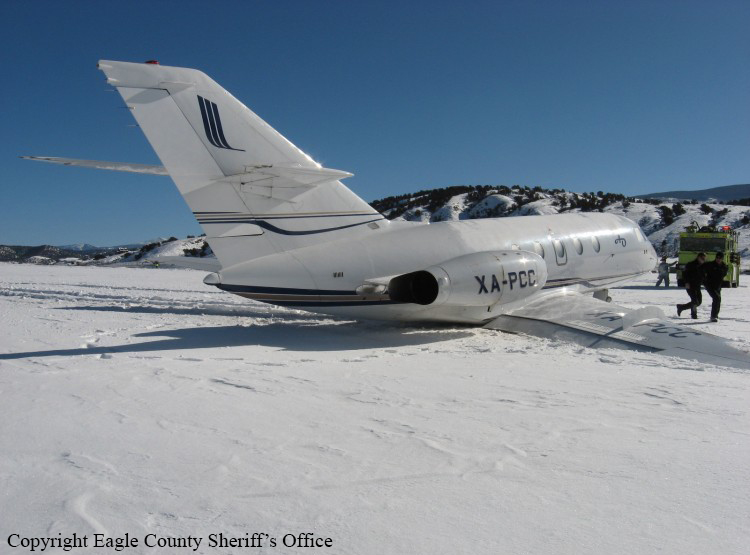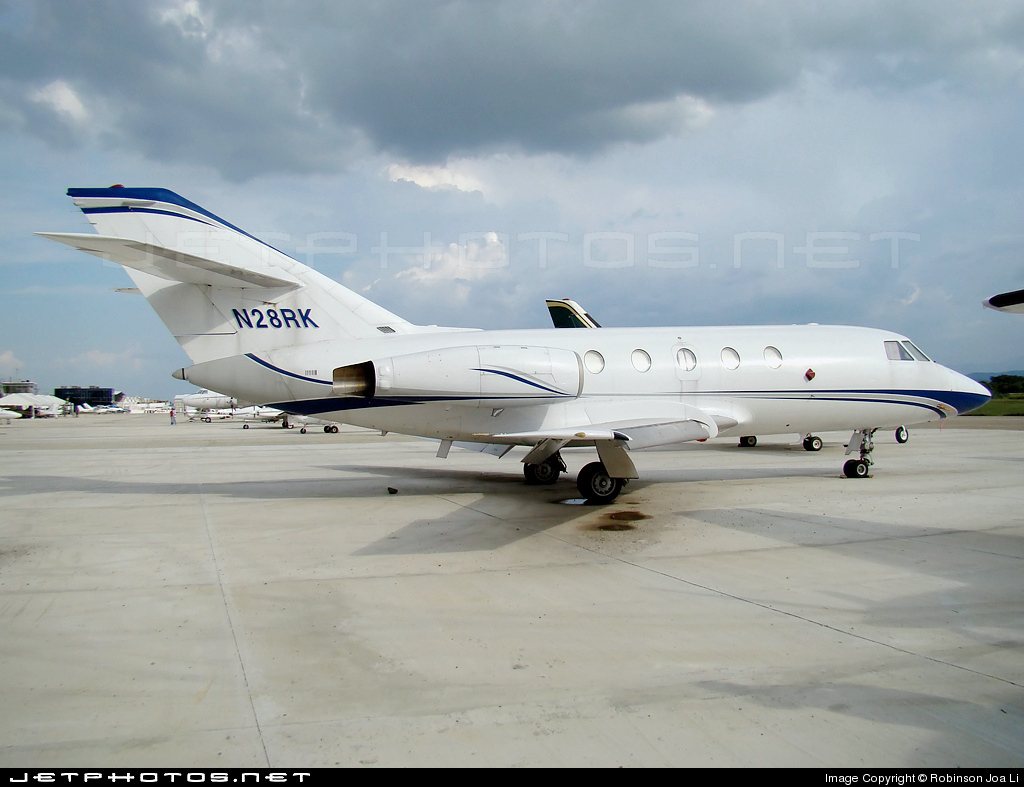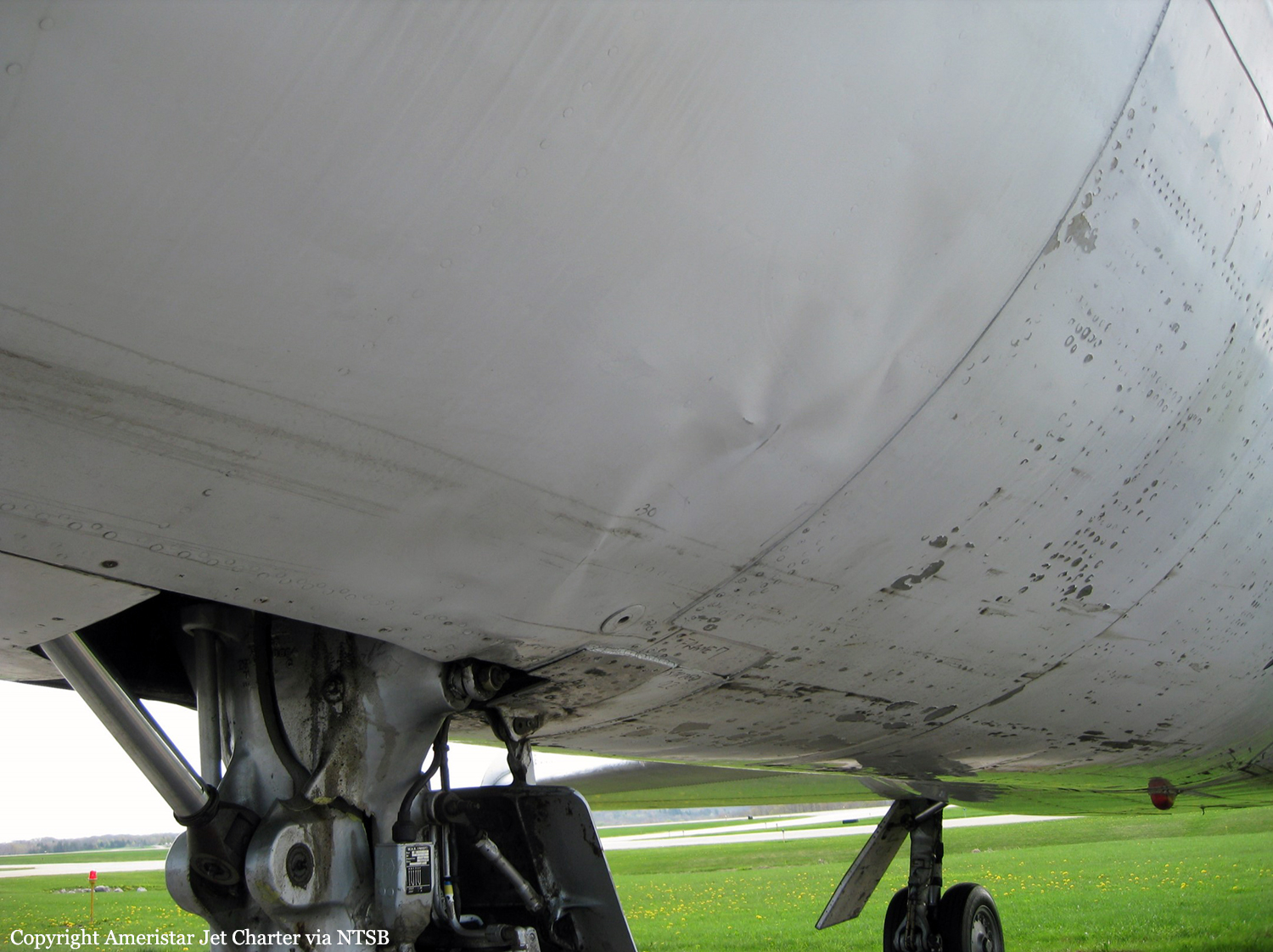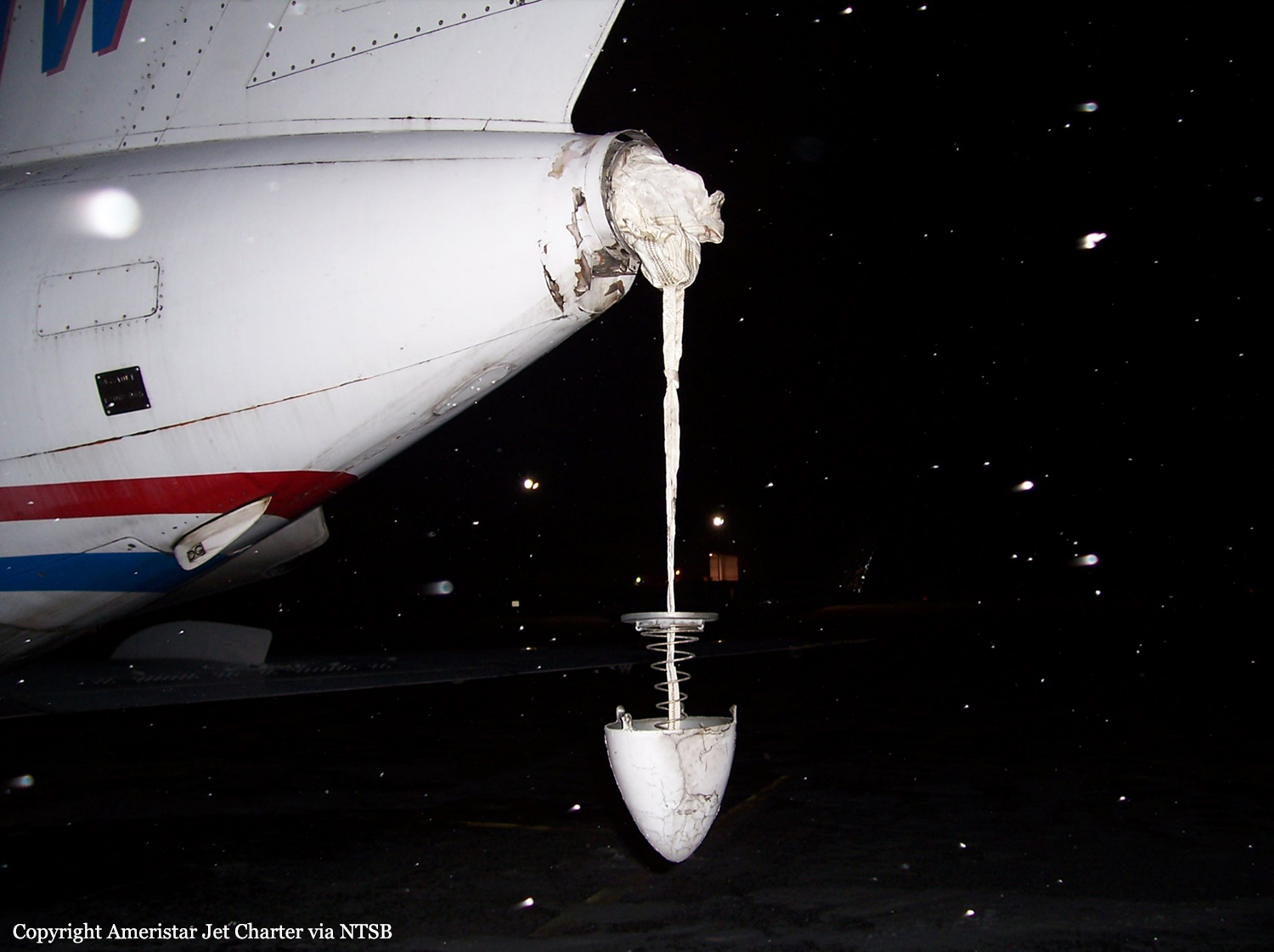Country
Ground accident of a Dassault Falcon 20F in Newnan
Date & Time:
Oct 3, 2011
Registration:
XA-NCC
Survivors:
Yes
MSN:
264
YOM:
1972
Crew on board:
1
Crew fatalities:
Pax on board:
0
Pax fatalities:
Other fatalities:
Total fatalities:
0
Circumstances:
A technician was in charge to ferry the airplane to a hangar for a maintenance control. While taxiing, the Falcon went out of control, rolled down an embankment and collided with a utility pole. The nose was severely damaged and the aircraft was damaged beyond repair. According to the technician, who escaped uninjured, the brakes failed while taxiing.
Probable cause:
No investigation was conducted by the NTSB.


Crash of a Dassault Falcon 20F in Chiclayo
Date & Time:
Jun 18, 2010 at 1930 LT
Registration:
FAP-300/OB-1433
Survivors:
Yes
Schedule:
Chiclayo – Lima
MSN:
434
YOM:
1983
Crew on board:
2
Crew fatalities:
Pax on board:
6
Pax fatalities:
Other fatalities:
Total fatalities:
0
Circumstances:
Shortly after takeoff from Chiclayo Airport, while climbing, the crew contacted ATC, reported technical problems and was cleared for an immediate return. On final approach, the crew was forced to make an emergency landing when the aircraft crash landed about 500 metres short of runway. All 8 occupants escaped uninjured while the aircraft was damaged beyond repair.
Probable cause:
One of the engine failed during initial climb for unknown reasons.

Crash of a Dassault Falcon 20C in Vail
Date & Time:
Jan 8, 2010 at 1225 LT
Registration:
XA-PCC
Survivors:
Yes
Schedule:
Vail - Chihuahua
MSN:
159
YOM:
1968
Crew on board:
2
Crew fatalities:
Pax on board:
5
Pax fatalities:
Other fatalities:
Total fatalities:
0
Captain / Total hours on type:
5000.00
Circumstances:
During taxi the airplane was observed to run over a tire chock with the left main gear tire. During a turn out of the ramp, the left main gear was observed to run over the nose gear chock that had been removed from the nose gear by the pilot during pre-flight. During the departure roll, the left main gear tire failed and the pilot elected to abort the takeoff attempt. The airplane did not stop on the remaining runway surface and departed the runway overrun area, coming to rest in snow-covered terrain. An examination of the airplane's systems revealed no anomalies.
Probable cause:
The flight crew’s improper preflight inspection and failure to remove the main landing gear wheel chock, resulting in damage and subsequent failure of the main landing gear tire during the takeoff roll.
Final Report:



Crash of a Dassault Falcon 20D in Matthew Town: 2 killed
Date & Time:
Dec 17, 2009 at 1930 LT
Registration:
N28RK
Survivors:
No
Schedule:
Oranjestad – La Isabela – Fort Lauderdale
MSN:
206
YOM:
1969
Crew on board:
2
Crew fatalities:
Pax on board:
0
Pax fatalities:
Other fatalities:
Total fatalities:
2
Circumstances:
On December 17, 2009 at approximately 7:30 pm local (2330UTC), N28RK a Dassault Sud, Falcon Fan Jet, Mystere 20, Series D aircraft which departed Joaquin Balaguer Int’l Airport (MDJB) in the Dominican Republic, for Ft Lauderdale Executive Airport, (FXE) Ft Lauderdale, Florida, USA, crashed in a remote area of Matthew Town, Great Inagua, Bahamas. The accident occurred approximately 11.5 miles due east of Great Inagua International Airport at coordinates N 20˚ 58’ 30” latitude and W 073˚ 40’ 00.7” longitude. The aircraft made contact with the terrain on a heading of approximately 105 degrees magnetic. The accident occurred in area that was not accessible by land and the investigation team had to be airlifted by helicopter to the site. Witnesses on the island of Great Inagua reported hearing a loud bang that rattled doors and windows of their homes, but they did not report seeing the aircraft fall from the sky. The aircraft was under the command of Captain Harold Roy Mangels and First Office Freddy Castro. The aircraft reportedly departed Aruba, in the Netherland Antilles and made a fuel stop at Dr. Joaquin Balaguer Int’l Airport, Santo Domingo in the Dominican Republic. The final destination filed by the crew was Ft. Lauderdale Executive Airport, Ft Lauderdale Florida. The accident occurred approximately 6 mile off the filed flight path. ATC records and instructions were for the aircraft N28RK to maintain 28,000 ft (FL280). The aircraft transponder was reported as inoperative. It begun a rapid descent, with no report of an emergency declared or mayday call out. Investigation of the crash site indicates the airplane made contact with the terrain at a high rate of speed and approximately a 45 degree angle. The aircraft was destroyed on impact. The crew of a United States Coast Guard helicopter was on a training mission in the Great Inagua area at the time of the accident. They reported hearing a loud bang and noticed a huge explosion and fireball emanating from the ground in an area close to their location. The crew of the US Coast Guard helicopter reported that they did not see any in-flight fire prior to the fireball that they saw. The post impact fire engulfed approximately five (5) acres of trees and brush in the National Wildlife Refuge at Great Inagua. The coast guard helicopter crew stated that they discontinued their training mission and went to the site to investigate. Upon arrival at the site the crew reported that they lowered rescue personnel to the ground to investigate and search for survivors, but, due to the heat and extent of the fire on the ground, they had to discontinue the search. They reported the accident to authorities at Great Inagua. This information was further passed along to the National Transportation Safety Board who alerted the accident investigation unit of the Bahamas Civil Aviation Department. Night time conditions prevailed at the time of the accident. The crew of the aircraft received fatal injuries. A search of the area discovered no distinguishable human remains. Approximately less than 1% of what is believed to be possible human flesh / internal body parts were recovered. In addition clothing (piece of a pant with belt buckle fastened) was recovered, which possibly may have been worn by a member of the crew at the time of the accident. All recovered remains and clothing retrieved were gathered by officers of the Royal Bahamas Police Force that accompanied the investigation team and sent to the Forensic Science Laboratory at the Royal Bahamas Police Force, Nassau Bahamas for DNA analysis and possible identification. The aircraft broke into many pieces after contact with the terrain. Debris was spread over a large area of rough terrain. What remained of the aircraft post impact was either not found or possibly further destroyed by the post impact fire. The “four corners” of the airplane were confirmed in the area downstream of where the initial ground impact occurred. However, engine cowling parts were found prior to the point of initial ground impact. This may suggest an aircraft over-speed condition prior to ground impact. Less than 10% of the aircraft was recovered. An explosion occurred when N28RK made contact with the terrain. A post impact fire ensued. Approximately 5 acres of the national park was destroyed by the fire. Parts of the aircraft including personal effect, aircraft parts and furnishing, seat and seat cushions were also destroyed in the post impact fire.
Probable cause:
The probable cause of this accident has been determined as loss of control. Insufficient wreckage of the aircraft were recovered to make a conclusive determination as to the cause of the accident.
Final Report:




Crash of a Dassault Falcon 20C in Jamestown
Date & Time:
Dec 21, 2008 at 0100 LT
Registration:
N165TW
Survivors:
Yes
Schedule:
Tulsa – Jamestown
MSN:
65
YOM:
1966
Crew on board:
2
Crew fatalities:
Pax on board:
0
Pax fatalities:
Other fatalities:
Total fatalities:
0
Captain / Total hours on type:
1160.00
Copilot / Total hours on type:
80
Aircraft flight hours:
16360
Circumstances:
The co-pilot was performing a nighttime approach and landing to runway 25. No runway condition reports were received by the flight crew while airborne, and a NOTAM was in effect, stating, “thin loose snow over patchy thin ice.” After landing, the co-pilot called out that the airplane was sliding and the wheel brakes were ineffective. The captain took the controls, activated the air brakes, and instructed the co-pilot to deploy the drag chute. The crew could not stop the airplane in the remaining runway distance and the airplane overran the runway by approximately 100 feet. After departing the runway end, the landing gear contacted a snow berm that was the result of earlier plowing. The captain turned the airplane around and taxied to the ramp. Subsequent inspection of the airplane revealed a fractured nose gear strut and buckling of the fuselage. The spring-loaded drag chute extractor cap activated, but the parachute remained in its tail cone container. Both flight crewmembers reported that the runway was icy at the time of the accident and braking action was “nil.” The airport manager reported that when the airplane landed, no airport staff were on duty and had not been for several hours. He also reported that when the airport staff left for the evening, the runway conditions were adequate. The runway had been plowed and sanded approximately 20 hours prior to the accident, sanded two more times during the day, and no measurable precipitation was recorded within that time frame. The reason that the drag chute failed to deploy was not determined.
Probable cause:
The inability to stop the airplane on the remaining runway because of icy runway conditions. A factor was the failure of the drag chute to properly deploy.
Final Report:






